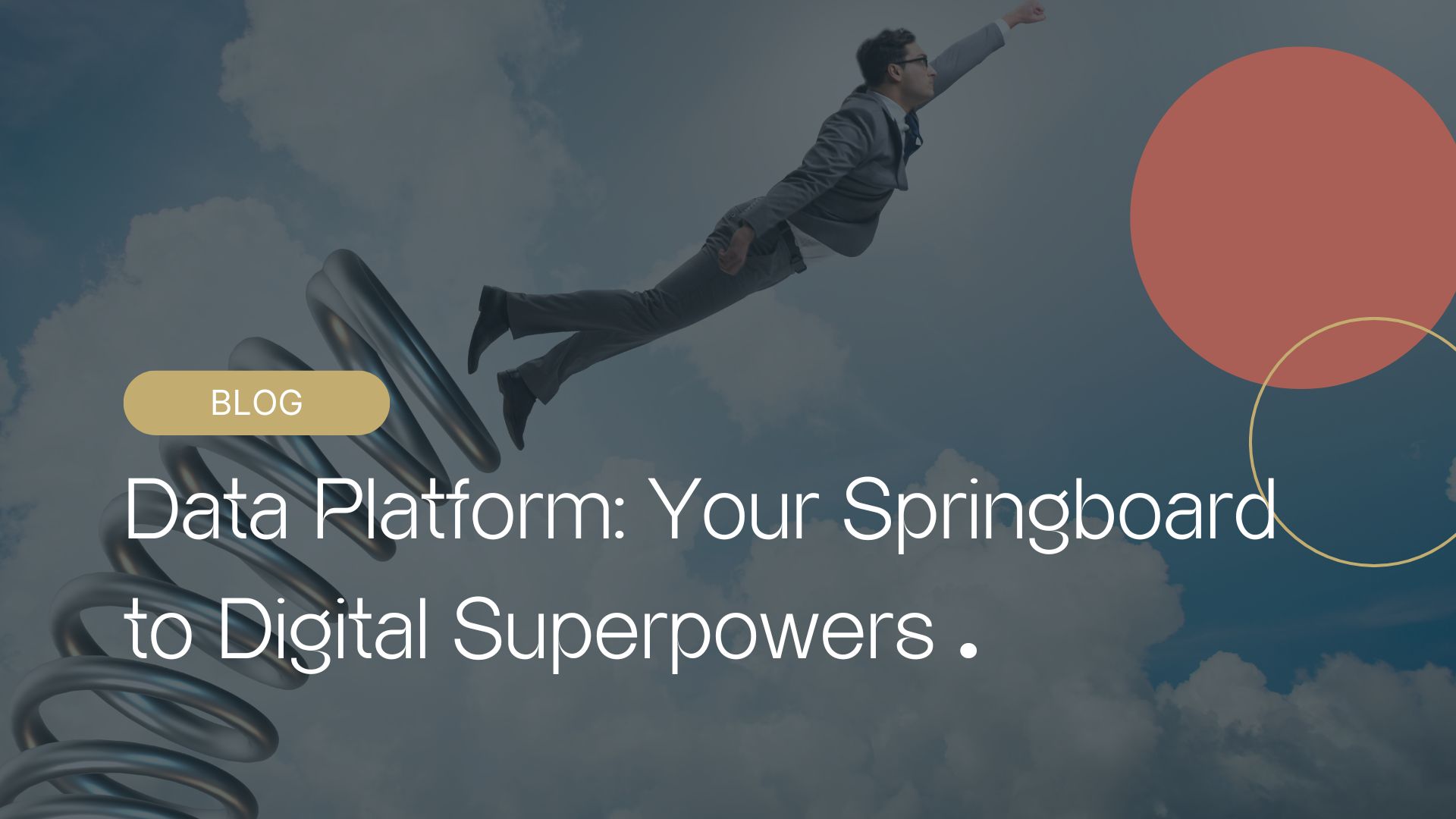
Data Platform: Your Springboard to Digital Superpowers
Imagine if you could talk to your data, and have it talk to you when you need it? Automatic alerts before budgets are stretched or customers are about to cancel? That’s the reality for businesses that have built their data platform right, and perhaps your next strategic move to secure your competitive advantage.
By: Jo Wesche Fossheim
What is a data platform?
A data platform is a business solution that consists of technologies and tools that retrieve data from isolated systems and transform it into structured information that can be used for, among other things, reports, analyses, automated alerts and valuable AI solutions.
Think about the difference between looking for answers directly in an ERP system (designed for transactions) versus having clear dashboards and insights delivered automatically, or by you typing a prompt, as you might already do in ChatGPT or Copilot.
The data platform works on three levels:
- Collects data from all your systems (CRM, ERP, other systems, files, etc.)
- Structures the information (cleans data, normalizes, removes duplicates, and connects everything)
- Delivers ready-made semantic models for use by AI agents, Microsoft Fabric/Power BI, Excel or other analysis tools
A properly built data platform gives you, to put it bluntly, “digital superpowers.” Let’s explore some of them.
Read also: Why data-driven management must become a strategic priority
Four data-driven superpowers data platforms give you
Here are some examples of what will be possible:
- AI-assisted insight: The agent never sleeps and can notify changes in, for example, sales data and suggest actions. No more Excel digging based on gut feeling. Result: Get a bonus employee who works 24/7 on improvements and insights.
- Financial clarity: Collects and harmonizes data frequently, providing the finance department with a dashboard with up-to-date, reliable key figures and forecasts. Result: better decisions on investments and cost management.
- Project management: View data from project tools, financial systems, and time tracking to provide updated status on budget vs. actual. Result: early warning and better control.
- Sales and risk management: Gives sales managers and finance a shared insight into margins and customer credit scores. Result: more profitable deals and reduced risk of loss.
Also read: What is composable ERP, and why is everyone talking about it?
From Excel number chaos to reliable decision-making power
It’s not uncommon to spend less than 20% of your time analyzing data , while 82% is spent searching for, preparing, and managing it . A data platform turns this situation on its head.
Instead of spending hours and days compiling monthly reports, you get updated insights continuously. Instead of arguing about which numbers are actually “right,” the entire organization has access to the same fresh, accurate, and unified truth about the business.
Business insights give your business the superpower to see where you’re going and how fast. When a data platform aggregates and harmonizes data from ERP, banking, and project management, finance gets a dashboard with up-to-date key figures and forecasts. This empowers managers to make decisions based on facts, not gut feelings – and act quickly on changes in liquidity or cost levels.
At the same time, research shows that data-driven companies see an average of 8% increase in revenue and 10% lower costs, and they are 19 times more likely to be profitable .
AI that actually works (because the data is structured)
The use of AI/KI is becoming perceived as a do or don’t for Norwegian companies. Yet Forrester Research highlights that 60% of AI projects fail, primarily due to poor data quality , which leads to inaccurate models and wrong decisions. In short: AI is not magic – without reliable, consistent and well-managed data, results become unreliable, and profitability fails .
When your data platform delivers high-quality, structured datasets, you can get reliable forecasts and automated answers to business questions like:
- “Which customers are at the greatest risk of ending the relationship?”
- “When should we order more raw materials based on seasonal patterns?”
- “Where do we find hidden inefficiencies in our processes?”
Instead of analysts spending 80% of their time on data washing, they can focus on strategic analysis that actually creates value. The data platform handles the boring but necessary work, and you can focus on the analytical and creative.
From chaos to control: The journey towards data-driven decisions
First, a little reality check: Does a data platform solve all data problems?
No. You can invest in the best technology and still struggle with the same challenges if the processes, expertise, and data culture don’t keep up. It takes work, but the returns can be enormous.
How long does it take to see results? Most larger companies already have some form of data platform, preferably a data warehouse or some tables in a database that feed a reporting tool. The question is whether it supports the needs of the future.
Whether you’re starting from scratch or upgrading your existing systems, the path to data-driven success follows these four phases:
Phase 1: Start with concrete business value
Identify one area where better data would make a dramatic difference. Perhaps production optimization, customer segmentation, or purchasing optimization. Start smart and small with concrete, measurable goals.
Phase 2: Build with modern cloud technology
Choose secure platforms like Microsoft Fabric, Azure, or Databricks. These services give you:
- Built-in links to hundreds of data sources
- Advanced reporting and analysis capabilities
- Scalable architecture that grows with your needs
- Good access to expertise
Phase 3: Implement advanced analytics capabilities
Once the data foundation is solid, you can expand with:
- Automated reports that are updated continuously
- AI agents that continuously work on your data
- Predictive analytics based on historical patterns
- Integrated systems that share the right data with each other
Phase 4: Scale your success across the organization
Once your data foundation is solid and your first pilot shows results, you can expand to other business areas and implement more advanced analytics capabilities.
How to get started with a data platform: Three concrete steps
Here are the practical steps you can take to get started:
- Map your data universe: Where does your valuable data reside today? In ERP, CRM, production systems, or perhaps scattered in Excel files? Start by understanding what data exists, which is business-critical, and which has the greatest potential.
- Choose a high-value area for your pilot project: Don’t start by building a cathedral. Build a cabin, it’s faster, and shows that the result is worth the effort. Focus on solving a concrete problem that provides measurable value within a few months. You can actually have a well-functioning pilot in place in under 100 hours.
- Think scalable from the start: Start small, but choose technology that grows with you. Cloud-based solutions allow you to expand from simple reports to advanced analytics without tearing down and rebuilding.
Also read: Excel in the manufacturing company: When is it time to consider ERP?
Common pitfalls and how to avoid them
Even the best data platform projects can go off track. Here are the most common mistakes we see:
- The ” Technology First ” approach : Don’t buy tools before you understand the business need. Start with the problem definition, not the solution architecture.
- The Ghost of Perfectionism : Don’t wait for the “complete” data platform. Implement incrementally and deliver value along the way.
- Underestimating the complexity of the source systems : Without sufficient ERP expertise, data models become incorrect, key fields are misunderstood, and processes such as invoicing, purchasing, and project costs are disconnected or misunderstood. Involve ERP expertise early in the project and build a data model that takes into account the business logic of the ERP system.
- Lack of good change management : Even the best technical solution fails if the organization does not adopt new work processes.
Conclusion: Data platform as a competitive advantage
Data is your hidden superpower, if you use it right. A robust data platform gives you the control, speed, and insight to make smarter choices in a rapidly changing world. While competitors drown in Excel sheets and data chaos, smart organizations are building the foundation to leverage AI and make accurate, data-driven decisions.
The question is not whether you will need a data platform, but whether you implement it early enough to turn data into a competitive advantage.
The future belongs to companies that make their data their strongest competitive advantage.
What are you waiting for?
Frequently asked questions about data platforms
1. What is a data platform?
A data platform is a solution that combines technologies to ingest, transform, and store data from various sources, so that data can be analyzed, visualized, and used in AI and decision-making processes.
2. What is the difference between a data platform and a data warehouse?
A data warehouse often focuses on storing and historical analysis of structured data. A data platform includes this as well as data integration, data cleansing, streaming/real-time analytics, and services for leveraging data in AI and automation.
3. Why do businesses need a data platform?
A data platform can help break down data silos, improve data quality, automate reporting, and provide faster insights. It enables better decision-making and efficient use of data resources.
4. How do you implement a data platform in a business?
Start by mapping existing data sources and identifying a specific area of high value. Then build a pilot solution that can be scaled over time. Choosing cloud technology and modularity is important for flexibility.
5. What are the benefits of a data platform?
A modern data platform provides businesses with several benefits:
– Improved data quality and consistency
– Reduced manual reporting
– Faster, more informed decisions
– Enabling AI and automation
– Increased competitiveness and innovation
6. How long does it take to implement a data platform?
The time varies greatly depending on the maturity of the company, the complexity of the data sources, and the capacity of the organization. A simple pilot can be set up in weeks to months, while a full rollout can take longer. Typically, a pilot can be built in 4–8 weeks, while a full implementation varies from a few months to over a year, depending on the complexity.
7. What technologies are used in a data platform?
A data platform is often built on modern cloud services such as Microsoft Fabric, Azure or Databricks. It combines databases, data integration tools, data governance, monitoring, analytics tools such as Power BI or Excel, and often AI components that support predictive analytics or automation.
8. How does a data platform support artificial intelligence and machine learning?
A data platform structures and prepares data so that it can be used by AI models, in addition to having AI functionality built into the services in the data platform itself. In sum, this results in increased automation and efficiency, better data quality, which in turn leads to more accurate models, reliable predictions and automated business decisions.
Author

Jo Wesche Fossheim
Jo Wesche Fossheim is Director BI & Analytics at Arribatec Norway and is passionate about making data accessible and useful throughout the organization. He has extensive experience in BI/CPM, budgeting and forecasting, reporting and analysis, always with a focus on value creation. Jo leads teams and projects that connect strategy and execution across industries, using technology such as Microsoft Fabric, Power BI, Hypergene, Unit4 ERP and RamBase. MSc in Economics and Administration from Trondheim University of Economics.


